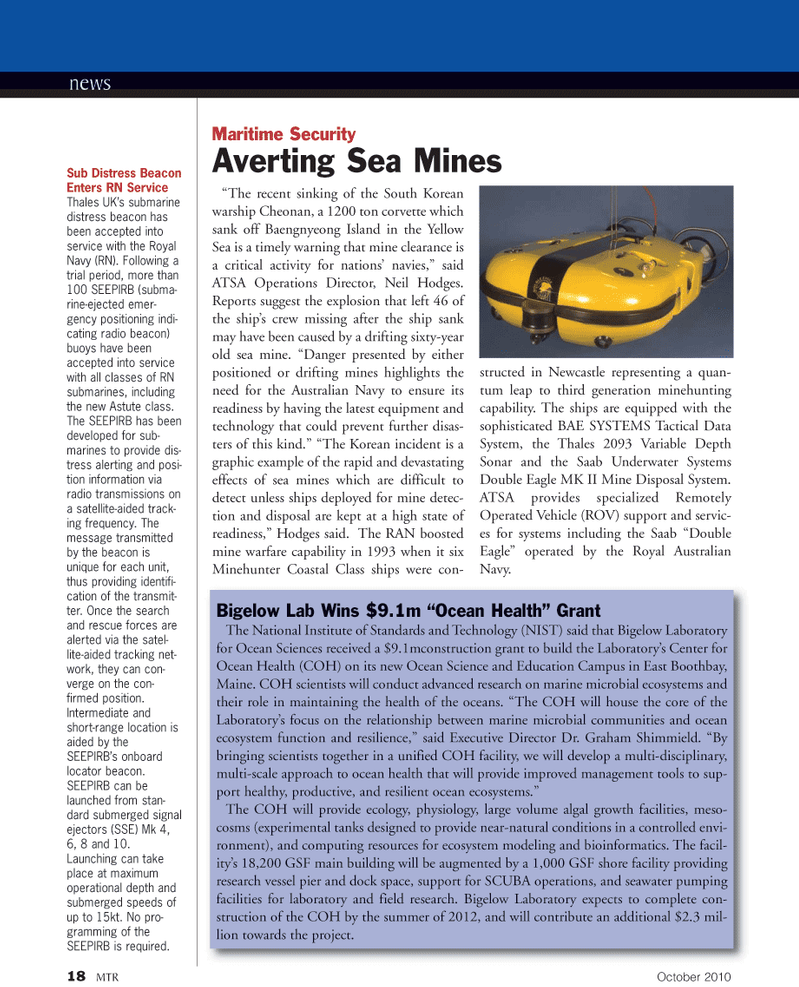
Page 18: of Marine Technology Magazine (October 2010)
Ocean Engineering & Design
Read this page in Pdf, Flash or Html5 edition of October 2010 Marine Technology Magazine
18 MTR October 2010 news
Sub Distress Beacon
Enters RN Service
Thales UK’s submarine distress beacon has been accepted into service with the Royal
Navy (RN). Following a trial period, more than 100 SEEPIRB (subma- rine-ejected emer- gency positioning indi- cating radio beacon) buoys have been accepted into service with all classes of RN submarines, including the new Astute class.
The SEEPIRB has been developed for sub- marines to provide dis- tress alerting and posi- tion information via radio transmissions on a satellite-aided track- ing frequency. The message transmitted by the beacon is unique for each unit, thus providing identifi- cation of the transmit- ter. Once the search and rescue forces are alerted via the satel- lite-aided tracking net- work, they can con- verge on the con- firmed position.
Intermediate and short-range location is aided by the
SEEPIRB’s onboard locator beacon.
SEEPIRB can be launched from stan- dard submerged signal ejectors (SSE) Mk 4, 6, 8 and 10.
Launching can take place at maximum operational depth and submerged speeds of up to 15kt. No pro- gramming of the
SEEPIRB is required. “The recent sinking of the South Korean warship Cheonan, a 1200 ton corvette which sank off Baengnyeong Island in the Yellow
Sea is a timely warning that mine clearance is a critical activity for nations’ navies,” said
ATSA Operations Director, Neil Hodges.
Reports suggest the explosion that left 46 of the ship’s crew missing after the ship sank may have been caused by a drifting sixty-year old sea mine. “Danger presented by either positioned or drifting mines highlights the need for the Australian Navy to ensure its readiness by having the latest equipment and technology that could prevent further disas- ters of this kind.” “The Korean incident is a graphic example of the rapid and devastating effects of sea mines which are difficult to detect unless ships deployed for mine detec- tion and disposal are kept at a high state of readiness,” Hodges said. The RAN boosted mine warfare capability in 1993 when it six
Minehunter Coastal Class ships were con- structed in Newcastle representing a quan- tum leap to third generation minehunting capability. The ships are equipped with the sophisticated BAE SYSTEMS Tactical Data
System, the Thales 2093 Variable Depth
Sonar and the Saab Underwater Systems
Double Eagle MK II Mine Disposal System.
ATSA provides specialized Remotely
Operated Vehicle (ROV) support and servic- es for systems including the Saab “Double
Eagle” operated by the Royal Australian
Navy.
Maritime Security
Averting Sea Mines
Bigelow Lab Wins $9.1m “Ocean Health” Grant
The National Institute of Standards and Technology (NIST) said that Bigelow Laboratory for Ocean Sciences received a $9.1mconstruction grant to build the Laboratory’s Center for
Ocean Health (COH) on its new Ocean Science and Education Campus in East Boothbay,
Maine. COH scientists will conduct advanced research on marine microbial ecosystems and their role in maintaining the health of the oceans. “The COH will house the core of the
Laboratory’s focus on the relationship between marine microbial communities and ocean ecosystem function and resilience,” said Executive Director Dr. Graham Shimmield. “By bringing scientists together in a unified COH facility, we will develop a multi-disciplinary, multi-scale approach to ocean health that will provide improved management tools to sup- port healthy, productive, and resilient ocean ecosystems.”
The COH will provide ecology, physiology, large volume algal growth facilities, meso- cosms (experimental tanks designed to provide near-natural conditions in a controlled envi- ronment), and computing resources for ecosystem modeling and bioinformatics. The facil- ity’s 18,200 GSF main building will be augmented by a 1,000 GSF shore facility providing research vessel pier and dock space, support for SCUBA operations, and seawater pumping facilities for laboratory and field research. Bigelow Laboratory expects to complete con- struction of the COH by the summer of 2012, and will contribute an additional $2.3 mil- lion towards the project.

 17
17

 19
19
